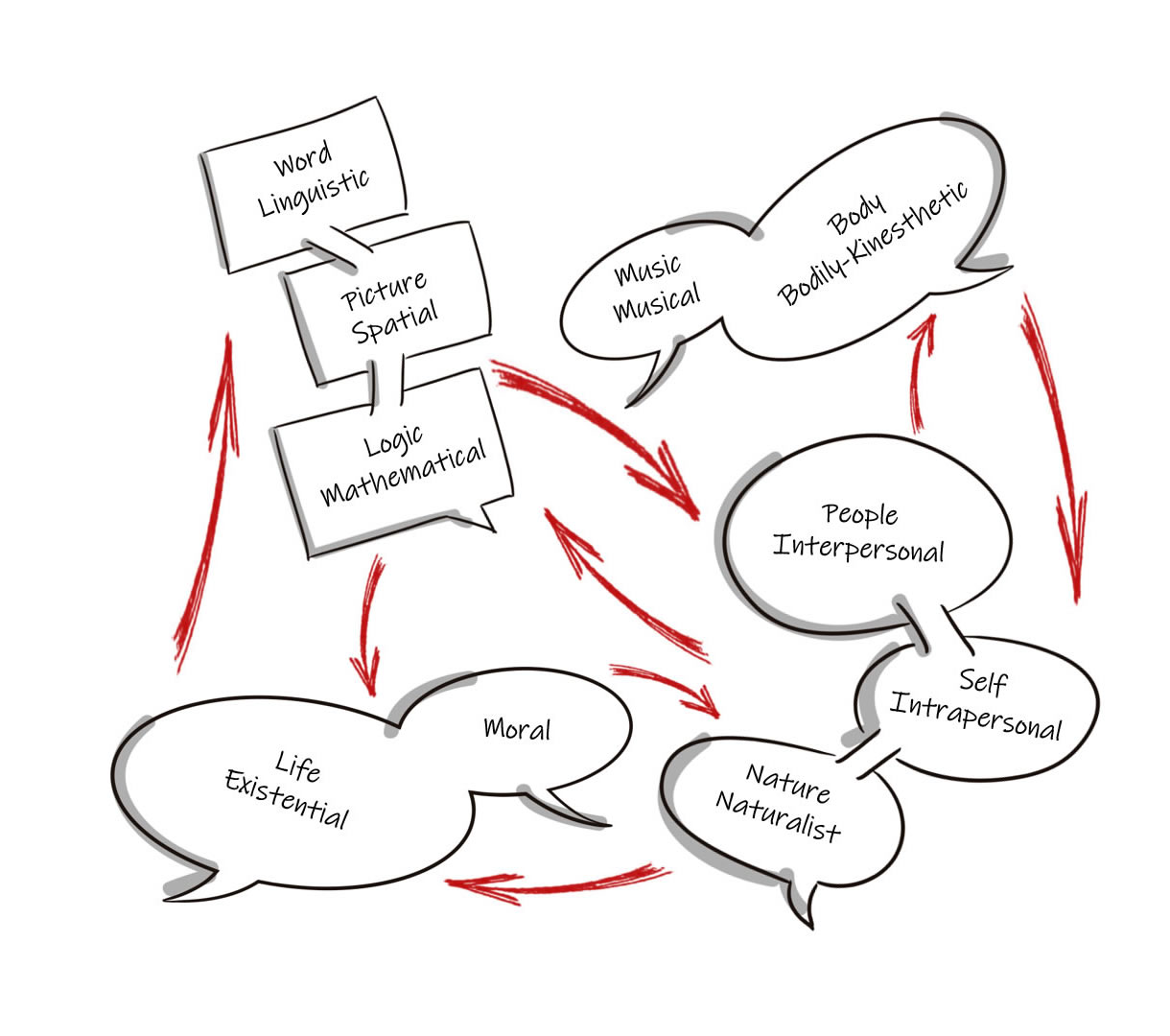Multiple Intelligences and Artificial Intelligence
Introduction
Multiple Intelligences and Artificial Intelligence
Intelligence Quotient
Albert Einstein has a high value for IQ.
 IQ stands for Intelligence Quotient.
IQ stands for Intelligence Quotient.
IQ tests focus mostly on logical and linguistic intelligence. IQ can’t predict what our children will do when they grow up or what they can achieve in their life.
We don’t need Intelligence Quotient.
Our children are SMARTER than we think.
People who haven’t scored well on IQ tests or who haven’t even been tested on what they’re good at doing, but who are clearly very smart in many other ways.
Young people today are being educated for jobs that don’t exist. They will be using technology that hasn’t been invented and will have to solve problems that haven’t yet emerged. We live in a world of accelerating change. We are increasingly being surrounded by exponential technologies and ubiquitous Artificial Intelligence. Whatever can be automated and outsourced, will be automated and outsourced.
Whatever can be done by AI will be done by AI.
Multiple Intelligences
Howard Gardner proposed Multiple Intelligences Theory, and it was developed in the past years.
 Gardner defines an intelligence as "bio-psychological potential to process information that can be activated in a cultural setting to solve problems or create products that are of value in a culture." According to Gardner, there are more ways to do this than just through logical and linguistic intelligence. Gardner believes that the purpose of schooling "should be to develop intelligences and to help people reach vocational and avocational goals that are appropriate to their particular spectrum of intelligences.
Gardner defines an intelligence as "bio-psychological potential to process information that can be activated in a cultural setting to solve problems or create products that are of value in a culture." According to Gardner, there are more ways to do this than just through logical and linguistic intelligence. Gardner believes that the purpose of schooling "should be to develop intelligences and to help people reach vocational and avocational goals that are appropriate to their particular spectrum of intelligences.
Word Smart
Linguistic Intelligence

Like words.
Use words in reading, writing and speaking.
Picture Smart
Spatial Intelligence

Look at the world.
Picture things or images. Show others your visions through art, design, photography, architecture, or invention.
Music Smart
Musical Intelligence

Appreciate music, rhythm, melody, and patterns in sounds.
Hear tones and pitch.
Body Smart
Bodily-Kinesthetic Intelligence

Be graceful and comfortable in your body.
Use body to learn new skills or to express yourself in different ways.
Logic Smart
Mathematical Intelligence

Figure things out.
Understand numbers and math concepts.
People Smart
Interpersonal Intelligence

Be interested in other people and how people interact with each other.
Self Smart
Intrapersonal Intelligence

Be aware of and understand your own feeling, what you are good at and the areas you want to improve.
Understand yourself better than others understand you.
Life Smart
Existential Intelligence

Think a lot about life.
Enjoy discussions related to religious, spiritual, or philosophical issues. Like to meditate, pray, or think about life.
Nature Smart
Naturalist Intelligence

Be observant.
Enjoy identifying and classifying things.
Moral Smart
Moral Intelligence

Understand right from wrong.
Behave based on the value that is believed to be right.
Make the most of all our children’s smarts
Help you learn about:
who your children are?
who your children can be?
Every children has different strengths and different ideas about how to do things.
All intelligences are different, but they are equal.
No matter what kind of ability the child has in a given smart, he/she can explore, grow, and develop it.
The child is not limited to one kind of intelligence.
There are many different ways of being smart in each intelligence.
 Multiple Intelligences work together!
Multiple Intelligences work together!
Children will be better served by a broader vision of education, wherein parents and teachers use different methodologies, exercises and activities to reach all children.
One of the real challenge is to innovate fundamentally in education.
Innovation is hard, because it means doing something that people don’t find very easy, for the most part.
It means challenging what we take for granted, things that we think are obvious.
The great problem for reform or transformation is the tyranny of common sense.
Things that people think "It can’t be done differently, that’s how it’s done."

Design Artificial Intelligence Machines
Artificial Intelligence is developing so fast in these years. AI machines also need these Multiple Intelligences.
Now
- IBM Watson is a question-answering computer system capable of answering questions posed in natural language. It beat the best human champions in the quiz show Jeopardy. What is not generally appreciated is that Watson’s knowledge was not hand-coded by engineers. Watson got it by reading Wikipedia — all 200 million pages of it.
- AIVA (Artificial Intelligence Virtual Artist) is a system that composes music for films. It recently released “Genesis,” its first album, and has officially become the first AI to acquire the worldwide status of Composer. It has even been registered under the France and Luxembourg authors’ right society (SACEM), and its work is copyrighted in its own name. The title track from the album is sublime and deeply moving. To think that a non-human could create something this powerful and emotionally moving is hard to believe. You have to hear it to believe it. And once you do, it will shake you to the core.
- Google’s Deep Dream system can create art. It is a program that adjusts an image to stimulate the pattern recognition capabilities of a deep neural network. By running the image recognition programme backwards, Deep Dream was able to generate phantasmagoric pagodas, psychedelic dogs, alien-looking plants and so on — images that looked haunting and hallucinatory and not a little disconcerting when we realise that no human had programmed these systems to create art and we had little idea how the system was doing it.
- Robots can swim like an octopus, glide like a snake, fly like an insect, walk like a dog, run like a human, and even do precision surgery. In fact, Boston Dynamics’ Atlas robot can even do somersaults and backflips.
- Siri, Google Now, and Cortana are all smart agents or intelligent digital personal assistants on various platforms (iOS, Android, and Windows Mobile). Their primary ability is to understand human speech and retrieve relevant information.
- AlphaGo uses a Monte Carlo tree search algorithm to find its moves based on knowledge acquired through machine learning and using artificial neural networks.。






IN FUTURE
Above AI machines or AI technologies have already gotten some in the scope of Multiple Intelligences. However, to make AI machines get profound Multiple Intelligences, or what is called Enhanced Artificial Intelligence, both software with algorithms and hardware should be advanced hand by hand.
In future, our children will live, work with these AI machines, such as robots, droids, smart apparatus, autopilots, drones together. They will be a huge family.

In future, Who is smarter?
Our children? Artificial Intelligence Machines?
 Artificial Intelligence Machines and our children are both our offspring.
Artificial Intelligence Machines and our children are both our offspring.
When our offspring use all of their intelligences as much as they can, they will fill the world with a marvelous tune that nothing else can make.